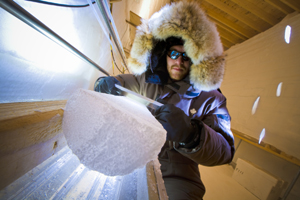Today's global warming follows more than 1000 years of colder climates
A new international study of past climate shows that the global temperature was getting colder and colder for more than 1000 years until the year 1900, after which global warming raised the temperature significantly in just 100 years. The study is based on more than 500 different data series from around the world. The findings are published in the prestigious journal, Nature Geoscience.

Bo Vinther cleans the surface of an ice core before measuring the acidity, which can reveal whether there are volcanic layers in the ice core.
The new survey of past climate is based on a series of studies of various types of phenomena in nature that are sensitive to temperature – such as data from tree rings, pollen data, stalagmites, sediments from lakes and seabeds and ice cores from the large ice sheets. It is precisely the interpretation of the Greenland and Antarctic ice cores that Associate Professor Bo Vinther from the Niels Bohr Institute’s Centre for Ice and Climate is working with.
Regional climate variability and global cooling
“The interesting thing about the new study is that it is now possible to create a picture of both global and regional climate changes using the many different data series. Thus, you can see that the Medieval Warm Period and the so-called Little Ice Age were not global phenomena. While it was warm in Europe during the Medieval Warm Period approximately 1000 years ago, it was cool in South America. And Antarctica had a mild climate period in the late 1600s, while Europe experienced severe frost and cold during the culmination of the Little Ice Age in the exact same period,” explains Bo Vinther, an ice core researcher at the Centre for Ice and Climate, Niels Bohr Institute at the University of Copenhagen.
When calculating a global average from the more than 500 temperature sensitive data series, it turns out that the temperature generally fell from around the year 600 onwards. This decrease was then interrupted by the global warming we have experienced in the last 100 years. The temperatures over the last 30 years in particular have been higher than any other period in almost 1,400 years.
Volcanic eruptions seen in ice cores
You can also find traces of past volcanic eruptions in the ice cores using measurements of the acidity of the ice. This is because large volcanic eruptions can send sulphur more than 30 km into the atmosphere where it spreads around the globe over several years, slowly being leached out as sulphuric acid, which is deposited in the ice.
The results show a correlation between the global cooling and increased volcanic activity, which has been recorded in the ice cores. This is because the sulphur from the volcanic eruptions reflects sunlight, so less light reaches the Earth’s surface, which thus cools.
“Over the past centuries, a decrease in volcanic activity along with the huge emissions of greenhouse gases has ensured that the decline in global mean temperature has been replaced by a sharp rise in temperature,” concludes Bo Vinther.
Article in Nature Geoscience >>
